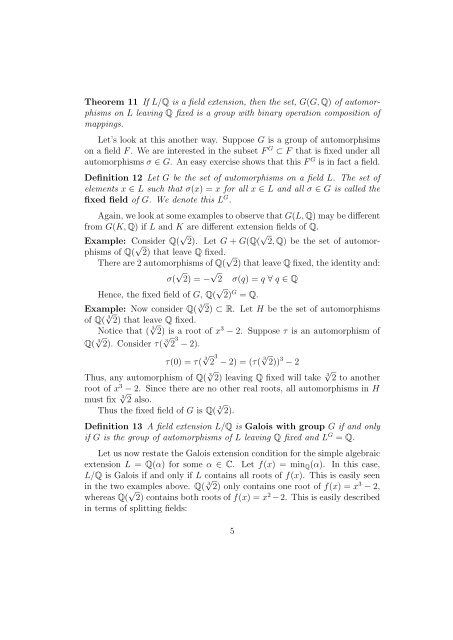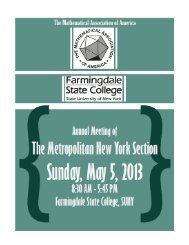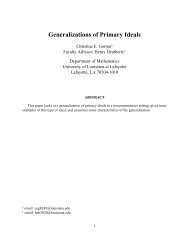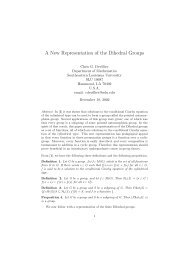Galois Theory and Noether's Problem Meredith Blue ... - MAA Sections
Galois Theory and Noether's Problem Meredith Blue ... - MAA Sections
Galois Theory and Noether's Problem Meredith Blue ... - MAA Sections
Create successful ePaper yourself
Turn your PDF publications into a flip-book with our unique Google optimized e-Paper software.
Theorem 11 If L/Q is a field extension, then the set, G(G, Q) of automorphismson L leaving Q fixed is a group with binary operation composition ofmappings.Let’s look at this another way. Suppose G is a group of automorphsimson a field F . We are interested in the subset F G ⊂ F that is fixed under allautomorphisms σ ∈ G. An easy exercise shows that this F G is in fact a field.Definition 12 Let G be the set of automorphisms on a field L. The set ofelements x ∈ L such that σ(x) = x for all x ∈ L <strong>and</strong> all σ ∈ G is called thefixed field of G. We denote this L G .Again, we look at some examples to observe that G(L, Q) may be differentfrom G(K, Q) if L <strong>and</strong> K are different extension fields of Q.Example: Consider Q( √ 2). Let G + G(Q( √ 2, Q) be the set of automorphismsof Q( √ 2) that leave Q fixed.There are 2 automorphisms of Q( √ 2) that leave Q fixed, the identity <strong>and</strong>:σ( √ 2) = − √ 2 σ(q) = q ∀ q ∈ QHence, the fixed field of G, Q( √ 2) G = Q.Example: Now consider Q( 3√ 2) ⊂ R. Let H be the set of automorphismsof Q( 3√ 2) that leave Q fixed.Notice that ( 3√ 2) is a root of x 3 − 2. Suppose τ is an automorphism ofQ( 3√ 2). Consider τ( 3√ 2 3 − 2).τ(0) = τ( 3√ 2 3 − 2) = (τ( 3√ 2)) 3 − 2Thus, any automorphism of Q( 3√ 2) leaving Q fixed will take 3√ 2 to anotherroot of x 3 − 2. Since there are no other real roots, all automorphisms in Hmust fix 3√ 2 also.Thus the fixed field of G is Q( 3√ 2).Definition 13 A field extension L/Q is <strong>Galois</strong> with group G if <strong>and</strong> onlyif G is the group of automorphisms of L leaving Q fixed <strong>and</strong> L G = Q.Let us now restate the <strong>Galois</strong> extension condition for the simple algebraicextension L = Q(α) for some α ∈ C. Let f(x) = min Q (α). In this case,L/Q is <strong>Galois</strong> if <strong>and</strong> only if L contains all roots of f(x). This is easily seenin the two examples above. Q( 3√ 2) only contains one root of f(x) = x 3 − 2,whereas Q( √ 2) contains both roots of f(x) = x 2 −2. This is easily describedin terms of splitting fields:5
















